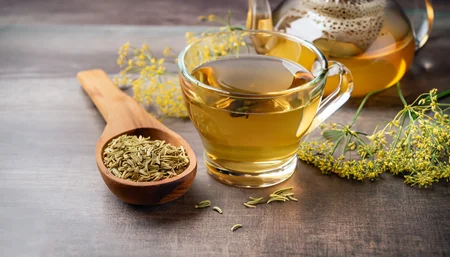
Table of Contents
Fennel And Fennel seeds in Ayurveda : Introduction
Fennel And Fennel seeds in Ayurveda : Did you know that the tiny fennel seeds you often chew after meals do more than just freshen your breath? In Ayurveda, Shatapushpa (fennel) is considered a remarkable herb that not only aids digestion but also balances hormones, soothes menstrual discomfort, and supports women’s health after childbirth. Having seen its impact in my clinical practice, I can say that fennel is a truly versatile healing herb with benefits that go far beyond the kitchen.
Ayurvedic Perspective on Fennel
Ayurveda evaluates every herb through its Rasa (taste), Guna (qualities), Virya (potency), Vipaka (post-digestive effect), Prabhav (unique action), and effects on Doshas. Fennel stands out due to its ability to calm Vata and Kapha while increasing Pitta.
- Scientific name: Anethum sowa
- Family: Umbelliferae
- Rasa (Taste): Katu (pungent), Tikta (bitter)
- Guna (Quality): Laghu (light), Tikshna (sharp)
- Virya (Potency): Ushna (heating)
- Vipaka (Post-digestive effect): Katu (pungent)
- Effect on Doshas: Pacifies Vata & Kapha, elevates Pitta
Classical Ayurvedic Benefits of Fennel
Ancient texts like Charaka Samhita and Bhavaprakasha describe fennel’s healing powers:
- Deepana: Stimulates digestive fire
- Pachana: Eliminates toxins (ama)
- Shoolahara: Relieves abdominal pain & cramps
- Akshi Roga: Beneficial for eye disorders
- Basti Karma: Used in enema therapy during Panchakarma
- Ruchidayak: Improves appetite
- Stanyajanana: Enhances breast milk production
- Pittakrut: Strengthens Pitta dosha
How to Use Fennel in Daily Life
Here are a few Ayurvedic remedies you can try at home:
1. Decoction for Gas & Bloating
Soak 10–15 g fennel seeds in hot water for 30 minutes, strain, and drink. Helps relieve heaviness, distension, and belching.
2. Remedy for Menstrual Cramps & Irregular Periods
Mix fennel, jaggery, and carom seeds in hot water, let it sit, and consume daily for a week before your expected period. Supports regular cycles and eases cramps.
3. Paste for Joint Pain
Make a paste from fresh fennel plants, warm slightly, and apply to affected joints. Relieves swelling and stiffness.
4. Relief for Sore Throat & Cold
Chew 3–5 g fennel seeds with sugar candy after meals to soothe throat irritation and ease cough.
5. Postpartum Support
Prepare a fennel seed infusion with lukewarm water. Traditionally used to ease pain, reduce bloating, and improve lactation.
Real-Life Case Studies
Relief from Bloating & Indigestion
A 31-year-old IT professional with chronic bloating experienced 50% relief within three weeks by chewing fennel after meals and drinking coriander-fennel tea.
IBS, Constipation & Heartburn
A 24-year-old student suffering from IBS improved with a fennel-brahmi infusion, which soothed digestion and reduced stress.
Hormonal Balance & Menstrual Health
A patient with irregular cycles and hot flashes benefitted from fennel tea with shatavari, which reduced symptoms, stabilized mood, and improved sleep.
Post-Delivery Care
A new mother struggling with low milk supply and flatulence reported improved lactation and digestion after consuming fennel tea with ghee and jaggery.
Parts of Fennel Used in Ayurveda
- Seeds: Chewed after meals for digestion & fresh breath
- Fennel Tea/Decoction: For bloating, cramps & postpartum care
- Fennel Oil: Massage for colic & abdominal discomfort
- Seed Powder: Used in Ayurvedic formulations like Hingwashtak Churna
- Fennel with Ghee: Common postpartum remedy for lactation & nutrition
Conclusion
In Ayurveda, Shatapushpa (fennel) is much more than a digestive aid. It is a holistic herb that improves gut health, regulates hormones, enhances lactation, reduces joint pain, and even supports emotional well-being. When used wisely under Ayurvedic guidance, fennel can be a true ally for long-term health and balance.
✨ Unique Angle: This version highlights both classical Ayurvedic wisdom and modern clinical experiences, making it authentic, informative, and engaging.
ALSO READ : Ayurvedic Oil : Bhringraj Oil – Benefits, Uses, and Precautions You Should Know
